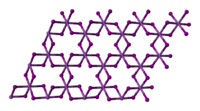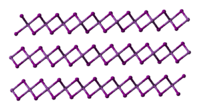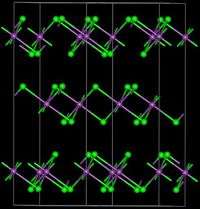Iron(III) bromide
 | |
 | |
 | |
| Names | |
|---|---|
| IUPAC name
Iron(III) bromide | |
| Other names
Ferric bromide Iron tribromide tribromoiron | |
| Identifiers | |
| 10031-26-2 | |
| 3D model (Jmol) | Interactive image |
| ChemSpider | 23830 |
| ECHA InfoCard | 100.030.069 |
| PubChem | 25554 |
| UNII | 9RDO128EH7 |
| |
| |
| Properties | |
| FeBr3 | |
| Molar mass | 295.56 g mol−1 |
| Appearance | brown solid |
| Odor | odorless |
| Density | 4.50 g cm−3 |
| Melting point | 200 °C (392 °F; 473 K) (decomposes) |
| Structure | |
| Trigonal, hR24 | |
| R-3, No. 148 | |
| Hazards | |
| Main hazards | corrosive |
| R-phrases | R36/37/38 |
| S-phrases | S26 S37/39 |
| NFPA 704 | |
| Except where otherwise noted, data are given for materials in their standard state (at 25 °C [77 °F], 100 kPa). | |
| | |
| Infobox references | |
Iron(III) bromide is the chemical compound with the formula FeBr3. Also known as ferric bromide, this red-brown odorless compound is used as a Lewis acid catalyst in the halogenation of aromatic compounds. It reacts with water to give acidic solutions.
Structure, synthesis and basic properties
FeBr3 forms a polymeric structure featuring six-coordinate, octahedral Fe centers.[1] Although inexpensively available commercially, FeBr3 can be prepared by treatment of iron metal with bromine:
- 2 Fe + 3 Br2 → 2 FeBr3
Above 200 °C, FeBr3 decomposes to ferrous bromide:
- 2FeBr3 → 2FeBr2 + Br2
Iron(III) chloride is considerably more stable, reflecting the greater oxidizing power of chlorine. FeI3 is not stable, as iron(III) will oxidize iodide ions.
See also
- Iron(II) bromide, the lower bromide of iron
References
- ↑ Holleman, A. F.; Wiberg, E. "Inorganic Chemistry" Academic Press: San Diego, 2001. ISBN 0-12-352651-5.
This article is issued from Wikipedia - version of the 7/8/2016. The text is available under the Creative Commons Attribution/Share Alike but additional terms may apply for the media files.
